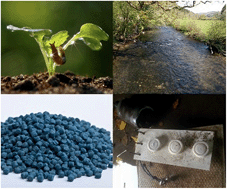Measuring metaldehyde in surface waters in the UK using two monitoring approaches†
Abstract
Metaldehyde is a molluscicide and the active ingredient in formulated slug pellets used for the protection of crops. Due to its mobility in the environment it is frequently found in river catchments, often at concentrations exceeding the EU Drinking Water Directive limit of 100 ng L−1 for a single pesticide. This presents a major problem for water companies in the UK where such waters are abstracted for production of potable drinking water supplies. Therefore, it is important to understand the sources, transport and fate of this emerging pollutant of concern in the aquatic environment. We monitored metaldehyde in two contrasting river catchments (River Dee (8 sites) and River Thames (6 sites)) over a twelve month period that coincided with the agricultural application period of the molluscicide. Spot samples of water were collected typically weekly or fortnightly. Chemcatcher® passive samplers were deployed consecutively every two weeks. At the River Dee, there was little variability in the concentrations of metaldehyde (<10–110 ng L−1) measured in the spot samples of water. The Chemcatcher® gave similar time-weighted average concentrations which were higher following increased rain fall events. At the River Thames, concentrations of metaldehyde varied more widely (<9–4200 ng L−1) with several samples exceeding 100 ng L−1. Generally these concentrations were reflected in the time-weighted average concentrations obtained using the Chemcatcher®. Both monitoring techniques gave complementary data for identifying input sources, and in the development of catchment management plans and environmental remediation strategies.



 Please wait while we load your content...
Please wait while we load your content...